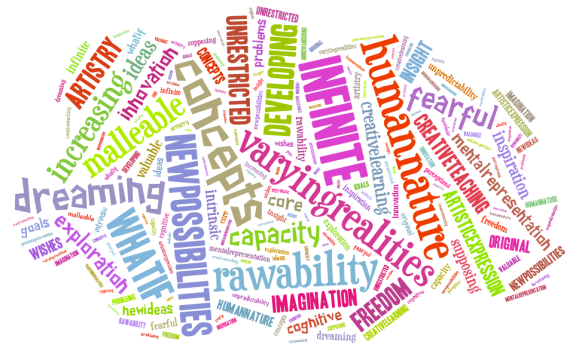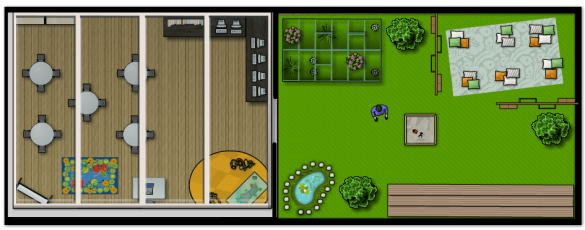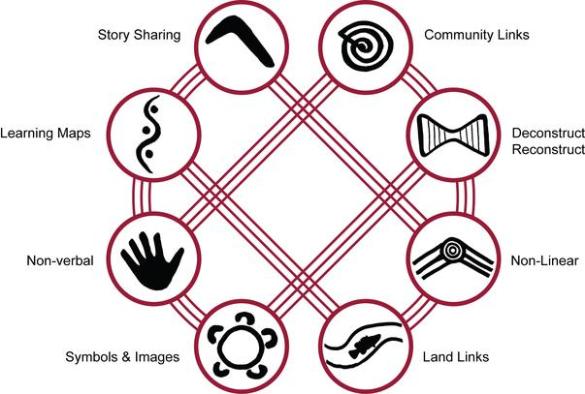For my online unit this week, I have had to create a photo visual of all the places where i use my imagination. Of course there are many more places but these are the ones i most frequently use. I used the program Photovisi which was very user friendly and quick to use.
Author Archives: tamarahookens
Creativity & Imagination Tagxedo
This week for my online unit, I have created a Tagxedo about the words ‘creativity’ and ‘imagination’. The words I used have come from my week 3 and 4 readings from the unit which was insightful and helpful for me to better understand these two terms which are so casually thrown around with so much meaning. My Tagxedo takes the shape of a cloud, as it reminded me of the word imagination and my initial thoughts about day dreaming as being one of the most basic definitions for the word.
How i feel about my online learning…
Online learning to me was a definite path to new learning that i would have some prior knowledge in. I was so wrong! It has been challenging on so many levels to see comprehend the multitudes of ways that i had been ignorant to learning.
I am definitely a lot more exposed now to the social aspects of learning online, something that i found difficult as breaking down that barrier in the beginning is hard. However, so many people have helped contribute to this unit and although they probably don’t realise, to my learning. I did often take cues from others and follow their example, especially at the beginning and that was fantastic in this space that i haven’t learnt in before.
I feel like i have done myself justice with online learning; i have tried my hardest and feel like it has been beneficial to me. I have enjoyed this unit and would look into doing another one in the future.
Future Learning Spaces: Rooftop Environment
The last assignment for the semester had us designing our own interpretation of a classroom of 2063. Being far off into the future made it difficult to predict but fun to play around with and plan.
On the top right hand part of my blog, next to my ‘About Me’ section there is a section titled ‘Future Education Environment’. On that page is a far more detailed plan of my rooftop classroom, my reasonings and thoughts.
Here are the design plans that i decided on for 2063.
Realigning a Lesson with 8ways
I’ve decided to go back and find one of my lessons I taught during my last teaching round. Below is my lesson; the revised sections have been underlined. I think its very important to bring together both western and 8ways pedagogies as children are exposed to different styles of learning
Learning OUTCOME (s)/STANDARD (s):
The students will describe movements, to follow simple directions.
Indicators
- The students will draw a pictures demonstrating direction (by teacher)
- The students will direct each other to reinforce this topic
Assessment:
Criteria
- The picture will show an understanding of correct directions
- When directing others, the students will use correct terminology such as ‘left, right, above, behind’
Lesson Resources: (list in dot point)
- A4 paper
- Books
- Squirrel and tree cutouts
Content of Lesson:
A. Introduction
To begin the lesson, the class will come to the floor to discuss what directional words are. To show children what the directional words are and what they mean, I will explain using a cutout of a squirrel and a tree on icy pole sticks. Putting the squirrel above the tree, and then asking them what this position means and then moving the squirrel to the right and asking them what that position means etc. All these directional words can then be subsequently written on the board. Story sharing, that is to say, a narrative involving the squirrel and the tree will help students attain a better grasp of prepositions. E.g. the squirrel saw the tree and wanted to climb up it. He didn’t know how to climb so he walked around the tree to get a better look. He looked to his left and saw a branch sticking out…etc.
B.Development (6 steps each with a focus question)
- After the squirrel and tree example, the whole class can sit in a circle with some books in the centre of the circle. One by one, the students can pick a word from the board, while directing another student to move the book to another position.
Question: Can you move the book on top to the right?
- Afterwards, the students can be told of all the different prepositions and the uses they have other than mathematics. In doing so, children can identify in their daily lives when they use these words.
Question: Does everyone know when we use words like this?
- The students will then be prompted to think of how to draw a picture of the directional words being used.
Question: How can we show what the word ‘above’ means?
C.Consolidation and Practice (4 to 6 steps)
- 1. Individually on A4 paper, students can be given one preposition and write out the word
Students can be given a word, and using an A4 piece of paper, can depict the meaning of the word through symbols and images. They can’t write the word but can use pictures, arrows and anything else to convey the meaning of their given preposition.
2. They can then use the remainder of the paper to draw out a picture displaying the meaning of the word
3. When finished, the students can write a sentence on the back, demonstrating they know how to use a word in a sentence
Early Finishers – Extension Activities
Students who finish early can form small groups and do the class activities like the books again, however include more objects in it so that it becomes more complex.
D. Closure
After the students have completed their drawings, they can be displayed in the classroom.
The students will sit together in a circle and show their picture to their classmates. If they have drawn their word correctly, their peers can easily guess it. However, to guess the word, the students must demonstrate it rather than yell the answer out aloud. This allows for creativity and non-verbal learning.
The students will be prompted to use the words more in their daily lives and see if they can try and learn some of the harder ones.
Kakadu Video
The 8 Ways framework was reflected in the Kakadu video; it showed the way rangers, Aboriginal citizens and tourists help make the frontier community. The National Park is a learning space as it conserves the natural state of the land and requires a lot of sustainability for it to be the way it is. By taking care of the park, knowledge from the past is used to help our future.
The video showed how the park in being cared for following Aboriginal ways of taking care of the land. Different areas are protected and it is great to see how traditional approaches are still being used because they are the most beneficial, as well as being what has been passed on for generations. Ultimately we see how important the land is to the Aboriginal people and how by looking after it, they can live peacefully.
8Ways Framework
The above image is the pinnacle of the 8 ways of Aboriginal learning.
8 Ways was designed to assist teachers to integrate western teaching with Aboriginal style teaching; the combinations of these two cultures means that it allows for learning for both teachers and students in multitudes of ways.
It helps teachers see another side of teaching, and allows students to learn in a manner they are more susceptible to learn from, regardless if from an Aboriginal teacher.
8 Ways allows educators to teach the Australian Curriculum, all the while including Aboriginal perspective into the classroom. This means that students are receiving their cultural education alongside their normal education which I think is nice as to not separate the two and think of different cultures needing to be separate.
Teachers who use the 8 Ways of teaching are responsible for catering to various learning styles as well as students they may have not previously dealt with, so it is a learning curve which provides experience and proves the lengths teachers strive to.
Here you can find the link to the 8Ways Page
The above post has taken a picture and knowledge from the 8 Ways Framework wiki space which can be found by following the link above.
It’s 2063 and the mining boom in WA is on its last legs. School communities have been temporary as mining companies moved their employees to more and more remote locations in the search for remaining resources. The National Broadband scheme is in place. Extended families live in far flung corners of the state. Your brief is to design a learning environment for these families that creates a sense of community that is currently missing.
I think that this scenario is not as far off as 2063, it is happening in our rural and remote areas in this day and age. Many families overcome the hurdle of living in remote Australia through home schooling as living in remote areas lends itself to less opportunities to receiving many dimensions of education.Communication technologies would help build up communities of practice that are essential for helping to connect communities, a must for remote locations.
In this environment, its important to bring communities together to allieviate the feeling of isolation through interacting with others in the community. This interaction allows children and families to grow socially, helps to build up a sense of community and belonging and allows individuals to understand that they are not the only ones dealing with situation. This can be done through the use of excursions and sport within the community, any gathering that allows all communities to share and interact.
The NBN is vital in bridging the communication barriers between those in rural and remote areas, all the while allowing individuals to engage in a virtual learning space. Children and adults both can engage in online communities of practise and can access social schooling networks in order to bring isolated communities closer together.
It’s 2063 and the population of Melbourne has risen to 10 million. Huge numbers of school-aged children live within the CBD, and have no access to rural and coastal victoria. Owing to the proliferation of high rise apartments, the local government has started to utilise the roof top spaces of these buildings as schools. You have been given a brief to design a classroom that brings rural and coastal Victoria to the city. The school is committed to environmental awareness owing to water restrictions and a depletion of natural resources.
Rooftop classrooms are both amazing in the way it lends itself to the buildings of the city, as well as an additional learning space for students. Inner city schools are limited due to the congestion of other buildings and instituations, and thus this concept is a great one as its creativity can immensly inspire students.
While the rooftop classrooms offers an alternative way of learning, it also provides an another dimension in which to teach children about sustainability. There is so much more potential in learning to preserve the environment in a classroom like this as it can be taken for granted in the city as opposed to a rural area.The city itself has little water resources which is why it is essential for students to learn about sustainable practises.
The downside of rooftop classrooms however, i think are the health and safety side of things as much of the learning is situated outdoors; given the climate of our city, how the classroom is designed will greatly impact how much worth a rooftop can offer in terms of a learning space.
In terms of this being a scenario of 2063, i think this is an idea already put in motion. Surely inner city schools have been established, but with a growing population more schools need to exist and in our city there is simply not enough space. While rooftop classrooms may not be the first way to handle this problem, perhaps it will be seen sooner rather than later.
Learning Spaces: My Multimedia Presentation
http://www.powtoon.com/p/cGVkMKzTy1e/#.Uj71sHAf5EI.twitter
The above link will direct you to my presentation (image below is what should come up).
Future Learning Spaces: Rare Earths
Future learning spaces depend wholeheartedly on what resources we have today. Oil is already one of the sources that globally has been depleted to the point where it has gotten more expensive cause it is hard to come by. In the same way, educational resources are heading in the same direction, namely due to the fact many people are unaware of where their technology comes from or how rare materials are!
With technology evolving more rapidly than ever, it has worked its way quite quickly into educational institutions. Schools are no different and have been open to the implementations of computers, laptops, and iPad’s among many of the most popular. Learning spaces of the future will encase more technology and will have students learn in more virtual ways than before.
However if sustainability problems of today show us anything, it is that shortage of resources is an ongoing problem, and in turn it will impact our schools. There are many rare element that our earth provides to us that without knowledge of it, we can take for granted. Continued use of our depleting sources will ensure that in time to come, none of it will be left (Rare Earth Technology Alliance, 2013). Furthermore, children of today and the future need to comprehend that beyond water, food and energy, our earth harnesses resources that we use in our technology and if we wish to continue, we have to reconsider how it is used. While we can take from our planet, we also have to nurture and give back to sustain ourselves.
How and Where I learn
When i have to study, read, learn or do assignments, i have specific places where i prefer to be. Overall, i like to be somewhere quiet, where i have access to my laptop and am relaxed.
First is my study desk in my bedroom; it is large, devoted to my uni course work and is a quiet space i have at home.
Next is my beanbag; located in my family room, i like to sit on it and watch TV while attempting to do work that i would otherwise procrastinate on.
At uni, my favourite place to learn is in the library; it is full of others who are trying to do the same and is usually quiet, full of resources and very convenient while i am in the city.
I like to learn by planning ahead, so i love my macbook pro as it helps me keep organised and have information readily available to me.
My Personal Taxonomy
Determining my own taxonomy was easy as i have a certain approach to learning and thinking can can be transferred to most things i undertake.
Step one: Outcome
- What do I want to get out of this activity?
- Am I doing it for myself?
Step Two: Goal Setting
- How will I get the best out of this activity?
Step Three: Options
- What questions do I have?
- Who can I talk to?
- How will i set it up?
- Where are my resources?
Step 4: Motiviation
- Complete it bit by bit
- Break up task with exercise
- Get all resources out before i start writing anything
Step 5: Evalution
- Double check my work as you go
- Did i get out of it what i wanted to
Step 6: Feedback
- Get someone to look over my work before submitting
What is a Taxonomy?
My understanding of taxonomy is that it refers to a set of learning goals or outcomes which are expected of the learner. By providing goals or alternatively thinking of the goals yourself, the learner is able to strive to achieve the outcome and the result will be a positive one.
Is the Curriculum a Group Learning Space?
As the curriculum is an established outline of what students will undertake in learning, I believe that its implementation in schools is important in achieving successful student learning. I see the curriculum being a collaborative and cooperative learning space, as teachers have to come together to understand it, share ideas and thoroughly plan how to best implement it in their classrooms.
The good thing about working corroboratively is that it allows for teachers to see the ideas that others have had that they may have overlooked. For example, this week a group of my peers and I were working on an assignment together and we had to plan a unit of work. Upon thinking of a topic ‘similarities and differences’ we each thought different things. I thought it could be about learning about different cultures, races and ethnicities, another person thought it meant the change between states such as solids, liquids and gases, whereas someone understood it to mean the opposites and synonyms. I think collaborative thinking enables teachers to a wider view of thinking which is an advantage any teacher should have.
Collaborative, cooperative and group learning spaces
I find that between the collaborative and the cooperative learning spaces, I can’t make much of a distinction except that in the cooperative learning spaces, individuals may be more enthusiastic to learn the ideas of others and share their own thoughts and resources whereas collaborative participants are more of a group effort. Which is personally how I view it but that just links back to group learning spaces. Perhaps the three are more interrelated than I initially thought and a combination of all is the best.
Collaborative and cooperative learning seems to be a more independent way to learn; simply that the students have to themselves set goals and seek information, which is a great way to become independent; it reminds me of inquiry work, where students learn better because it appeals to them and it is their own thinking.
Group learning seems like a more dependent method that the others as more teacher involvement occurs. I think the aid of a teacher benefits struggling students who can’t work in a group or can’t seek information themselves.
Ultimately as I thought before, I think a combination of all three learning spaces is what a teacher will want to achieve. The students to be willing, to be interested and contributing to group work, and well as working on their own in groups, but being able to partake in group discussions to allow for further thinking.
Twitter…
Twitter was something that i had already delved into during my high school years. Of course it was used as a more social and fun resources rather than one of learning. Having to change that mindset around to share learning and find others with similar educational backgrounds has been a challenge.
I think the best way to approach using something like Twitter which you may have used previously for another purpose is to start from scratch. So i did. I created a new account, followed a whole heap of new educators and peers, hoping for the best!
My twitter feed can now be viewed on the right hand column of my blog.
Students love online learning!
This weeks look at electronic spaces and online learning led me to a little YouTube search that produced this great video. Schools in Hong Kong share their experiences and journey with e-learning.
The Electronic Learning Space; An iPad does not a good teacher make, nor does it a good student make’
One of my first thoughts when reading the above statement is what benefit does the iPad serve to young students? My knowledge of learning styles came into play and I realised it caters to auditory, visual and kinaesthetic learners, so I believe its fair to say that is a great learning tool for a vast range of students whether or not it is being used well, all children take great interest in them. However its use in the classroom seems to vary based on a teachers ability to use and teach with one, as opposed to simply being used to distract and quiet students.
iPad’s like interactive whiteboards or mobile technologies need to be utilised in the best way and will surely then be an effective learning tool. Learning in the classroom surely is to help children comprehend the current technologies of their time so that they understand its uses and learn further. Whether or not the purpose of an iPad is clear now, eventually it will be and it will evolve to become something better; iPad’s are apart of the evolution from computers, to laptops. What will be next?
Teachers need to embrace new technologies and develop them in the classroom so that students are enthused to do the same. During my last placement I witnessed a teacher connect her iPad to her interactive whiteboard to demonstrate one of the maths games to her class. Teachers need to be more educated and competent before new technologies are brought into classrooms so that teachers can do awesome things like this instead of games only.
As iPad’s are present in most schools, it seems that instead of only encouraging education games, alternative activities should be introduced such as schools could partner up and have their students communicate with one other all the while learning how to utilise the iPad in communication purposes.
Beyond the Classroom; Communities of Practise
Communities of practice are established everywhere and we are involved in many. It is a procedure of learning simultaneously with others who share a passion for something and make an effort to learn more and as a result, frequently interrelate with their CoP.
CoPs vary in their characteristics but I suppose that is what is expected; having different interests and varied knowledge and ultimately different goals will ensure that different CoPs exist. Three crucial elements of a CoP are the domain, the community and the practice.
You can build the components of a CoP into your PLN by encouraging members to contribute regularly by sharing experiences or simply adding a comment. A new physical learning space can be greatly impacted upon through a CoP as many people, with the shared interest will be trying to help the best possible learning space be expanded.Through an online mode of the internet, pictures can be shared, as well as ideas and if necessary conferencing which enhances the experience.
The CoP in which I am a member of is my workplace; out of hours school care with the organization Camp Australia. I believe this is a practice as we are constantly trying to learn the best way to run the program and are always sharing experiences and resources with others of the same practice. The ‘domain’ involves the shared interest of children, the activities they become occupied in and their safety. The ‘community’ is an online forum of the organization in which members can talk and share thoughts. The ‘practice’ is our ongoing selection of activities and games and things of interest to the children which is constantly changing yet built upon by hundreds of members.






